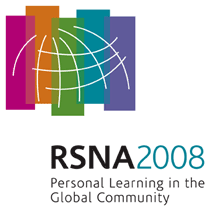
Abstract Archives of the RSNA, 2008
LL-GI4299-L03
Assesing Tumor Perfusion and Preoperative Treatment Response in Rectal Carcinoma Using by Perfusion CT
Scientific Posters
Presented on December 3, 2008
Presented as part of LL-GI-L: Gastrointestinal
Gaku Ohira, Presenter: Nothing to Disclose
Kiyohiko Shuto MD, PhD, Abstract Co-Author: Nothing to Disclose
Shiniti Okazumi, Abstract Co-Author: Nothing to Disclose
Tomoyoshi Aoyagi MD, Abstract Co-Author: Nothing to Disclose
Kazuo Narushima MD, PhD, Abstract Co-Author: Nothing to Disclose
Hisahiro Matsubara MD, PhD, Abstract Co-Author: Nothing to Disclose
Asami Satoh MD, Abstract Co-Author: Nothing to Disclose
Hiroshige Saito MD, Abstract Co-Author: Nothing to Disclose
Takumi Ota MD, Abstract Co-Author: Nothing to Disclose
et al, Abstract Co-Author: Nothing to Disclose
To evaluate the relationship between tumor blood flow measured by perfusion CT (P-CT) and clinocopathological findings, and to assess whether tumor blood flow correlate with the response of combined neoadjuvant chemoradiotherapy (CRT) in rectal carcinoma.
Seventy-nine consecutive patients of rectal cancer who underwent surgical resection were enrolled. Patient were divided into two groups (surgery alone group, N=67 and neoadjuvant CRT group, N=12). Prior to the treatment P-CT was performed using a 16-row MDCT scanner after intravenous injection of 40 ml iodinated contrast material at a rate of 5 ml/sec with a 5-mm thickness. Tumor blood flow (BF, ml/min/100g tissue) was measured by placing ROI in the maximum plane of the tumor using P-CT software based on the deconvolution method. Necrotic or hemorrhagic component were excluded in determining BF. In CRT group assessment was performed 4 weeks after the treatment including post-CRT BF by P-CT again and the therapeutic effect based on the RECIST criteria by endoscopy, barium enema and contrast CT (responder, N=8 and non-responder N=4). Retrospectively the correlation between BF and clinicopthological findings was investigated in surgery alone group. In CRT group, the changes of BF between pre- and post-CRT and the correlation between CRT response and BF were evaluated.
Significant positive correlation was observed between tumor size and blood flow (P=0.001). Those who had vessel invasion and adjacent organ invasion showed significantly higher BF (P=0.001, P=0.012, respectively). In CRT group, BF measured at post-CRT was significantly lower than that of pre-CRT (48.7 vs. 107.6, respectively. P=0.021). However there was no correlation with the response.
Blood flow, one of the perfusion CT parameter, had significant correlation with tumor size, vessel invasion, and adjacent organ invasion, and changes of tumor vasculature were visualized as tumor growth. Although decrease of the blood flow after CRT was detected, we could not find correlation with the response in this small sample size.
In this study, P-CT enable to visualize raised tumor blood flow according to tumor progression. P-CT may be applied to assess the neoadjuvant therapeutic effect including current anti-VEGF drugs.
Ohira, G,
Shuto, K,
Okazumi, S,
Aoyagi, T,
Narushima, K,
Matsubara, H,
Satoh, A,
Saito, H,
Ota, T,
et al, ,
Assesing Tumor Perfusion and Preoperative Treatment Response in Rectal Carcinoma Using by Perfusion CT. Radiological Society of North America 2008 Scientific Assembly and Annual Meeting, February 18 - February 20, 2008 ,Chicago IL.
http://archive.rsna.org/2008/6020610.html

